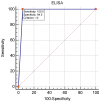Seroprevalence of West Nile Virus among Equids in Bulgaria in 2022 and Assessment of Some Risk Factors
- PMID: 38787181
- PMCID: PMC11126025
- DOI: 10.3390/vetsci11050209
Seroprevalence of West Nile Virus among Equids in Bulgaria in 2022 and Assessment of Some Risk Factors
Abstract
The aim of this study was to analyze the seroprevalence of West Nile virus (WNV) among equids in Bulgaria, confirm the results of a competitive ELISA versus the virus neutralization test (VNT) and investigate some predisposing factors for WNV seropositivity. A total of 378 serum samples from 15 provinces in northern and southern Bulgaria were tested. The samples originated from 314 horses and 64 donkeys, 135 males and 243 females, aged from 1 to 30 years. IgG and IgM antibodies against WNV protein E were detected by ELISA. ELISA-positive samples were additionally tested via VNT for WNV and Usutu virus. Thirty-five samples were WNV-positive by ELISA (9.26% [CI = 6.45-12.88]), of which 15 were confirmed by VNT; hence, the seroprevalence was 3.97% (CI = 2.22-6.55). No virus-neutralizing antibodies to Usutu virus were detected among the 35 WNV-ELISA-positive equids in Bulgaria. When compared with VNT, ELISA showed 100.0% sensitivity and 94.5% specificity. A statistical analysis showed that the risk factors associated with WNV seropositivity were the region (p < 0.0001), altitude of the locality (p < 0.0001), type of housing (p < 0.0001) and breed (p = 0.0365). The results of the study demonstrate, albeit indirectly, that WNV circulates among equids in northern and southern Bulgaria, indicating that they could be suitable sentinel animals for predicting human cases and determining the risk in these areas or regions of the country.
Keywords: ELISA; Usutu virus; VNT; WNV; donkeys; horses; seroprevalence.
Conflict of interest statement
The authors declare no conflicts of interest.
Figures



Similar articles
-
First Serologic Evidence of West Nile Virus and Usutu Virus Circulation Among Dogs in the Bulgarian Danube Region and Analysis of Some Risk Factors.Vet Sci. 2025 Apr 16;12(4):373. doi: 10.3390/vetsci12040373. Vet Sci. 2025. PMID: 40284875 Free PMC article.
-
Serological evidence of co-circulation of West Nile and Usutu viruses in equids from western Spain.Transbound Emerg Dis. 2021 May;68(3):1432-1444. doi: 10.1111/tbed.13810. Epub 2020 Sep 5. Transbound Emerg Dis. 2021. PMID: 32853452
-
Seroprevalence and Risk Factors for Equine West Nile Virus Infections in Eastern Germany, 2020.Viruses. 2022 May 30;14(6):1191. doi: 10.3390/v14061191. Viruses. 2022. PMID: 35746662 Free PMC article.
-
A Retrospective Study on the Seroprevalence of West Nile Virus Among Donkeys and Mules in Bulgaria.Vector Borne Zoonotic Dis. 2024 May;24(5):274-277. doi: 10.1089/vbz.2023.0095. Epub 2024 Jan 30. Vector Borne Zoonotic Dis. 2024. PMID: 38294797 Review.
-
A Scoping Review of West Nile Virus Seroprevalence Studies among African Equids.Pathogens. 2021 Jul 15;10(7):899. doi: 10.3390/pathogens10070899. Pathogens. 2021. PMID: 34358049 Free PMC article.
Cited by
-
The Role of Ruminants as Sentinel Animals in the Circulation of the West Nile Virus in Tunisia.Pathogens. 2025 Mar 8;14(3):267. doi: 10.3390/pathogens14030267. Pathogens. 2025. PMID: 40137752 Free PMC article.
-
An Overview of Infectious and Non-Infectious Causes of Pregnancy Losses in Equine.Animals (Basel). 2024 Jul 2;14(13):1961. doi: 10.3390/ani14131961. Animals (Basel). 2024. PMID: 38998073 Free PMC article. Review.
-
First Serologic Evidence of West Nile Virus and Usutu Virus Circulation Among Dogs in the Bulgarian Danube Region and Analysis of Some Risk Factors.Vet Sci. 2025 Apr 16;12(4):373. doi: 10.3390/vetsci12040373. Vet Sci. 2025. PMID: 40284875 Free PMC article.
References
-
- Postler T.S., Beer M., Blitvich B.J., Bukh J., de Lamballerie X., Drexler J.F., Imrie A., Kapoor A., Karganova G.G., Lemey P., et al. Renaming of the genus Flavivirus to Orthoflavivirus and extension of binomial species names within the family Flaviviridae. Arch. Virol. 2023;168:224. doi: 10.1007/s00705-023-05835-1. - DOI - PubMed
Grants and funding
LinkOut - more resources
Full Text Sources

